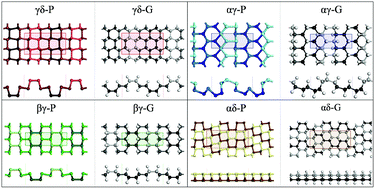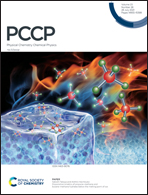New graphane: inspiration from the structure correlation with phosphorene†
Abstract
The application of phosphorene and graphane in different photoelectric devices and energy reserves has attracted wide attention. Here, we investigated the Raman spectra, phonon dispersion and vibration modes of four phosphorene monolayer polymorphs and four graphane allotropes with the corresponding crystal structures to analyze the structure correlation between them. Based on the “three identical, one divergent” pattern found in the sp3 hybrid atomic orbitals of phosphorene and graphane, four new graphane conformers with different hydrogenation modes named γδ-G, αγ-G, βγ-G and αδ-G are successfully predicted. Among these four new graphane conformers, βγ-G has the lowest binding energy, which is only 0.02 eV per atom higher than β-G, the most stable one among all graphane theoretically predicted. This means that βγ-G may co-exist with β-G during the experimental synthesis of graphane, which can be distinguished from the side views with threefold structures for βγ-G and twofold structures for β-G. All the new graphane conformers are direct-band-gap semiconductors with band gaps more than 3 eV, which indicate their great potential in optoelectronic devices. Furthermore, three of them exhibit in-plane negative Poisson's ratios under tensile deformation.



 Please wait while we load your content...
Please wait while we load your content...